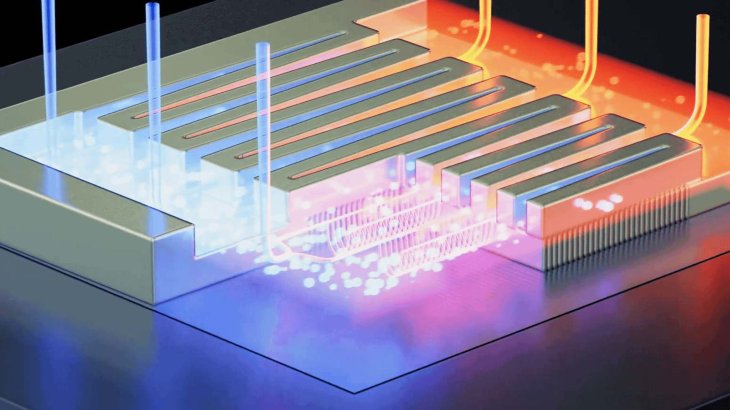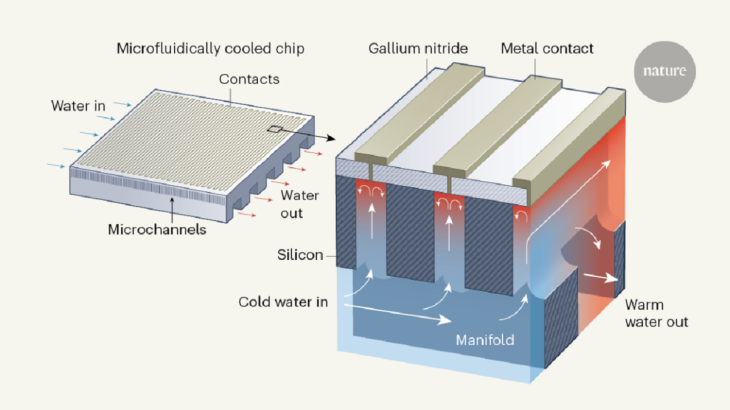New In-Chip Water Systems Will Keep Your Computer Chip From Overheating More Efficiently
Dhir Acharya - Sep 14, 2020

Researchers have designed a single-unit processor and cooling system with on-chip liquid channels, significantly boosting heat-limited situations.
- Like A Sci-Fi Movie, A Nail Salon In Dubai Is Offering Microchip Manicure
- Qualcomm Announced Snapdragon 888, The Next Mobile Chip For High-End Smartphones
- Elon Musk's Neuralink Brain-Chip Will Go Live Tomorrow
Researchers have designed a single-unit processor and cooling system that contain on-chip liquid channels next to the hottest parts of the computer chip, significantly boosting heat-limited situations.
When computer chips first surpassed the Gigaherzt level, everyone thought the processing speed would only increase. However, that faced a challenge when power requirements generated so much heat that a device couldn’t cool down and calculate. Event heat sinks, computer fans, and water cooling haven’t been able to surpass the heat level often slowing present processors.

A downside of liquid cooling systems is that they transfer heat energy from the processor into the water. With that in mind, the researchers tried to run the liquid inside the chip by placing on-chip liquid channels right next to the most heated areas of a processor, the study was reported by Ars Technica.
Heat extracting methods for chips involve multiple connections, from the chip through and to the packaging, to the heat sink. The chip could be placed into the liquid directly, but the liquid has to insulate without chemically reacting with the electronic components. Water cannot meet these requirements.
Over the years, we have seen a few illustrations of on-chip cooling systems, but the device integrated with the channels need to be fused onto a processor to help the system pump fluid.
While such systems removed heat energy, there’s a catch. It took more power to power the pump that moves water through the channels than it did to extract the heat from the chip, meaning these systems were not energy-efficient.

The researchers incorporate these ideas to raise the power efficiency of on-chip cooling solutions. They demonstrate the new method using a power-converting processor to avoid heat-energy-reduced performance.
It wasn’t simple to construct the new chip for this demonstration. Firstly, they had to cut extremely thin slits through GaN (gallium nitride), into the underlying silicon. Next, they conducted an etching process to make the channels wider, using copper to seal off the initial gaps through GaN.
This boosts the process of transferring heat into the water. There are alternating passages beneath the channels, working like sinks and feeds. Coldwater runs in through the feed, circulates up into the channel. It absorbs heat energy and moves out via an adjacent sink.
The device is configured so that the hottest parts of its GaN section are juxtaposed directly to one channel, which makes heat extraction more efficient. The best design the research team created could handle fluxes heated up to 1,700 W per square centimeter while preventing the temperature of the chip to cross 60 degrees C.
As quantum computers are coming, we need solutions to the heating issues in silicon-based chips so we can optimize computational power.
Featured Stories

Features - Jul 01, 2025
What Are The Fastest Passenger Vehicles Ever Created?

Features - Jun 25, 2025
Japan Hydrogen Breakthrough: Scientists Crack the Clean Energy Code with...

ICT News - Jun 25, 2025
AI Intimidation Tactics: CEOs Turn Flawed Technology Into Employee Fear Machine

Review - Jun 25, 2025
Windows 11 Problems: Is Microsoft's "Best" OS Actually Getting Worse?

Features - Jun 22, 2025
Telegram Founder Pavel Durov Plans to Split $14 Billion Fortune Among 106 Children

ICT News - Jun 22, 2025
Neuralink Telepathy Chip Enables Quadriplegic Rob Greiner to Control Games with...

Features - Jun 21, 2025
This Over $100 Bottle Has Nothing But Fresh Air Inside

Features - Jun 18, 2025
Best Mobile VPN Apps for Gaming 2025: Complete Guide

Features - Jun 18, 2025
A Math Formula Tells Us How Long Everything Will Live

Features - Jun 16, 2025
Comments
Sort by Newest | Popular